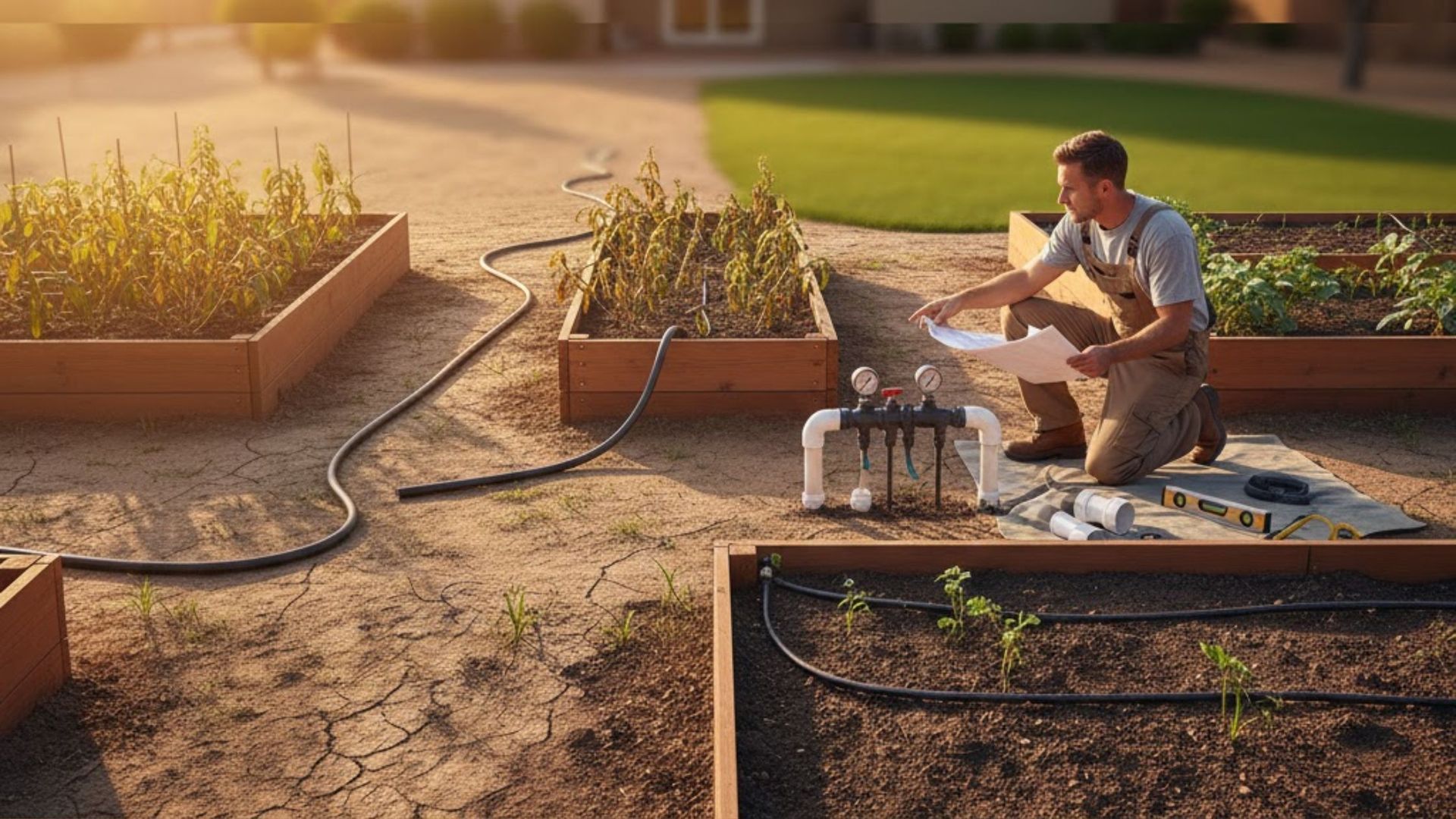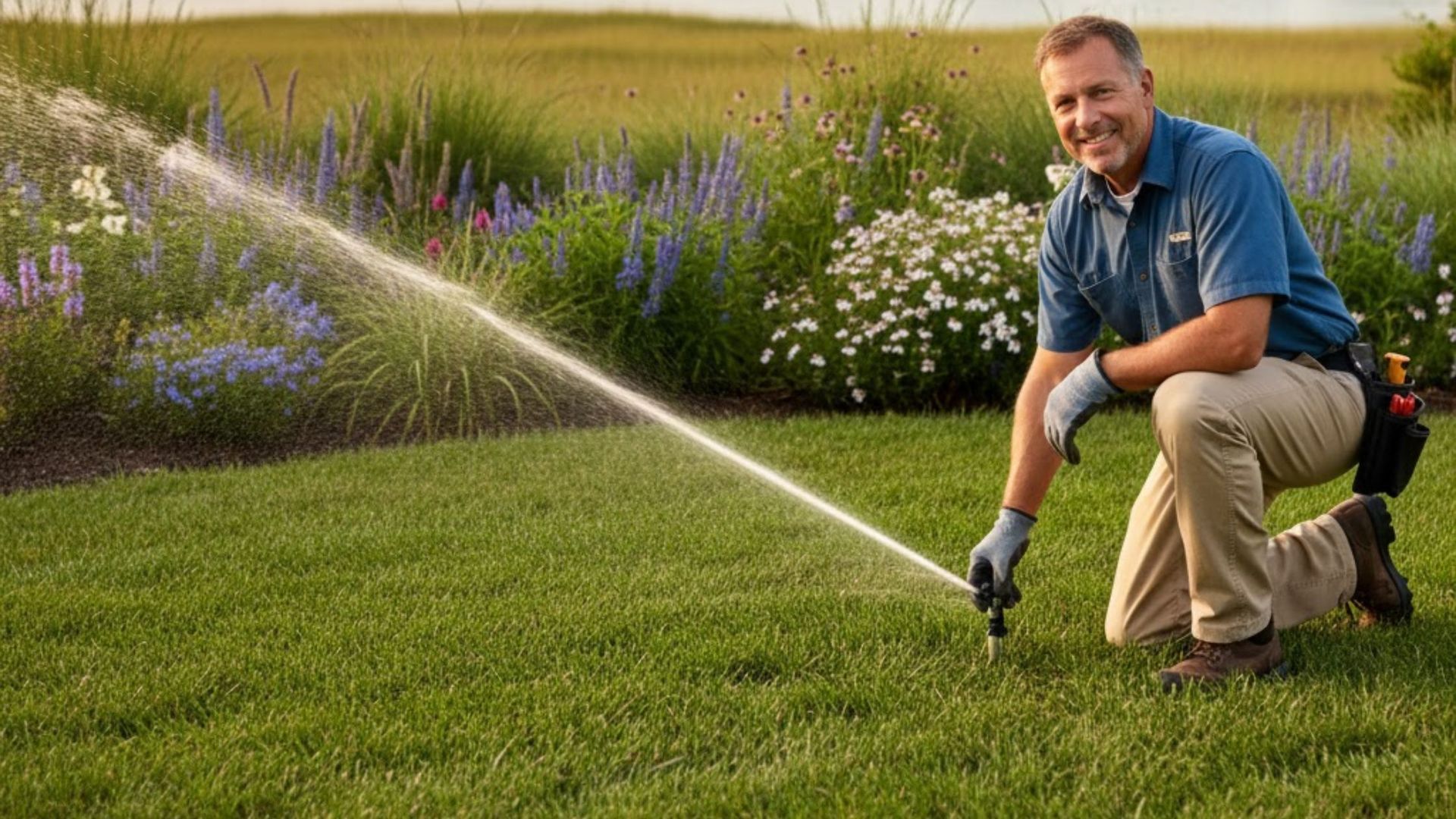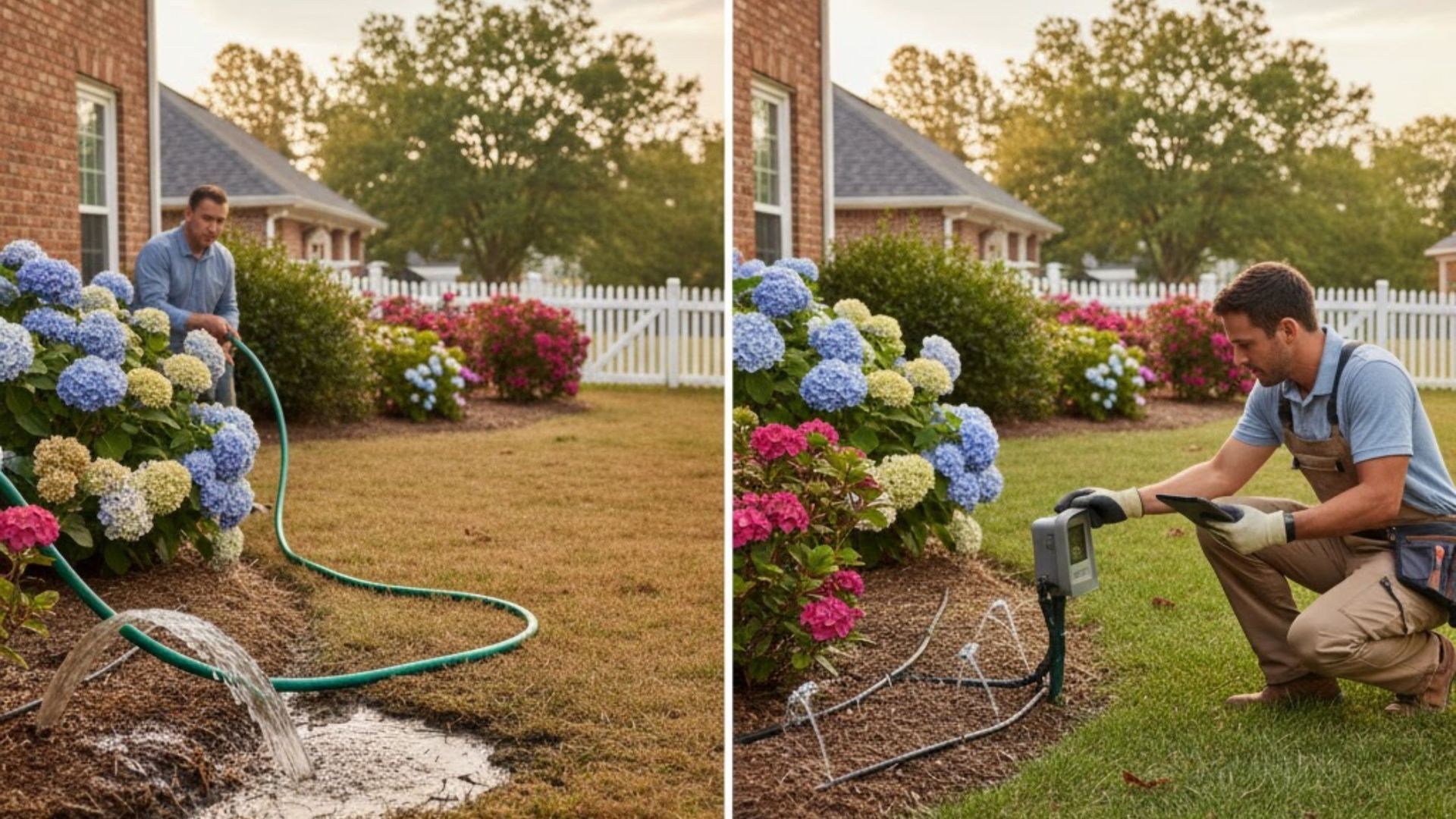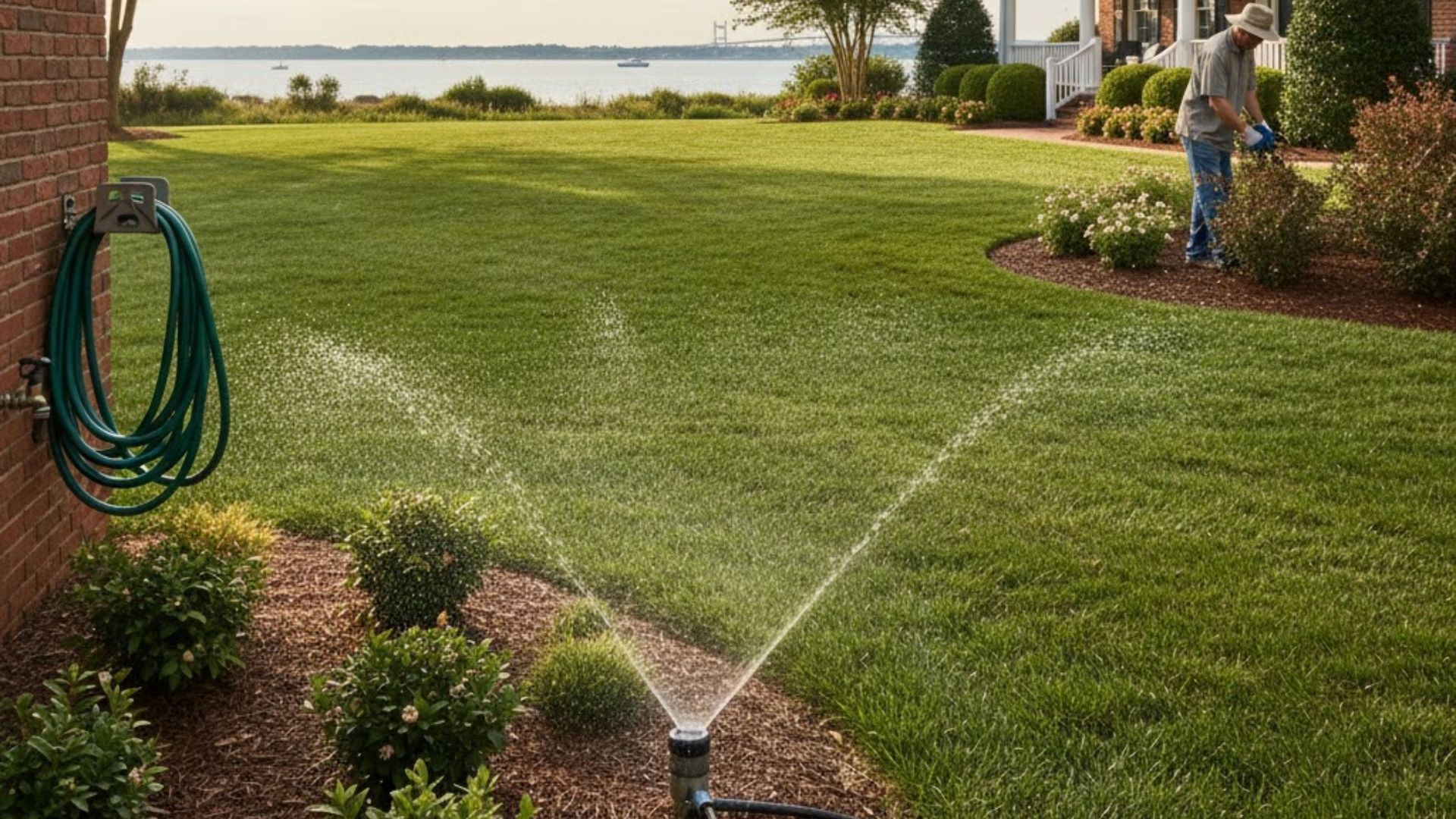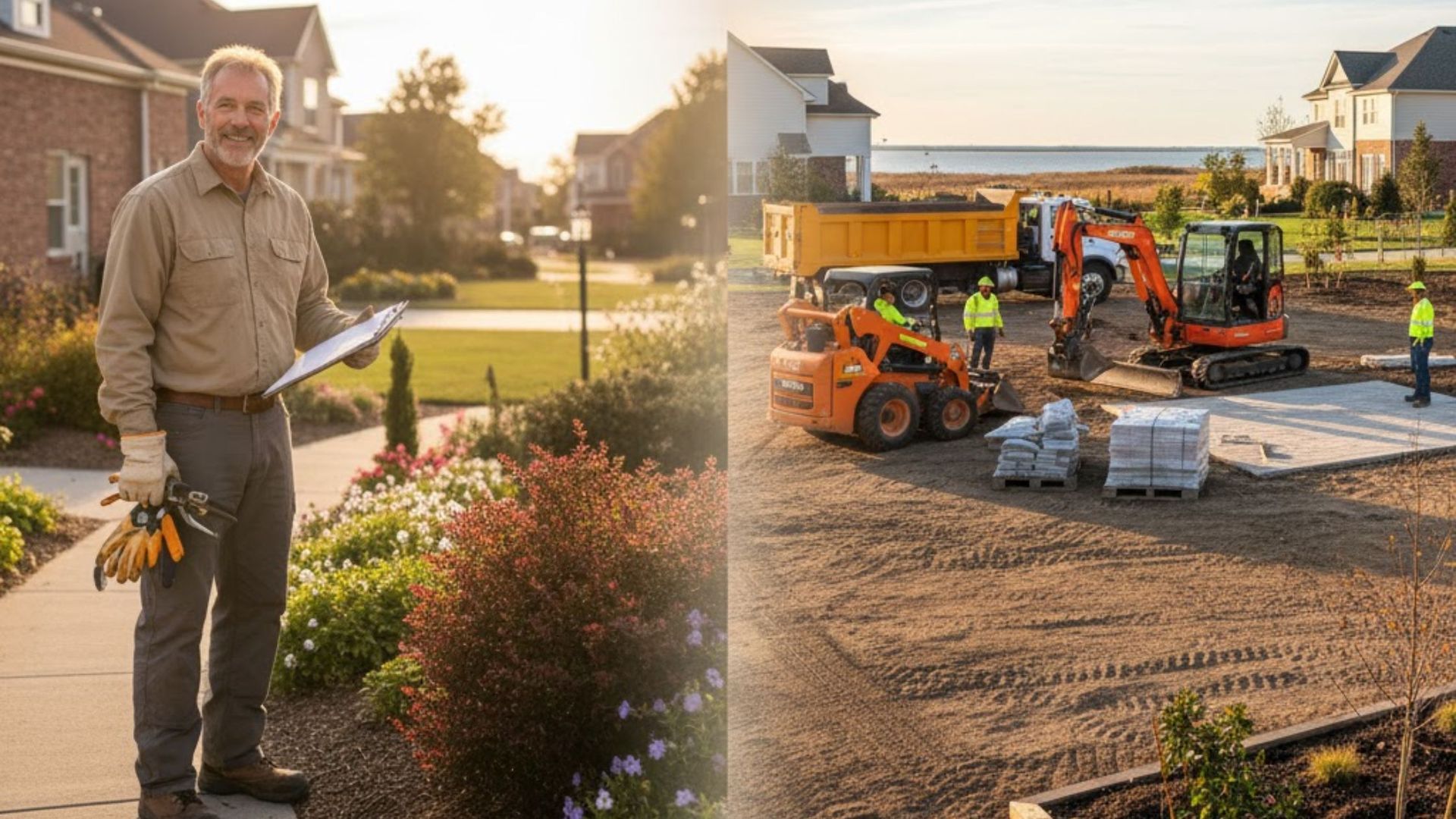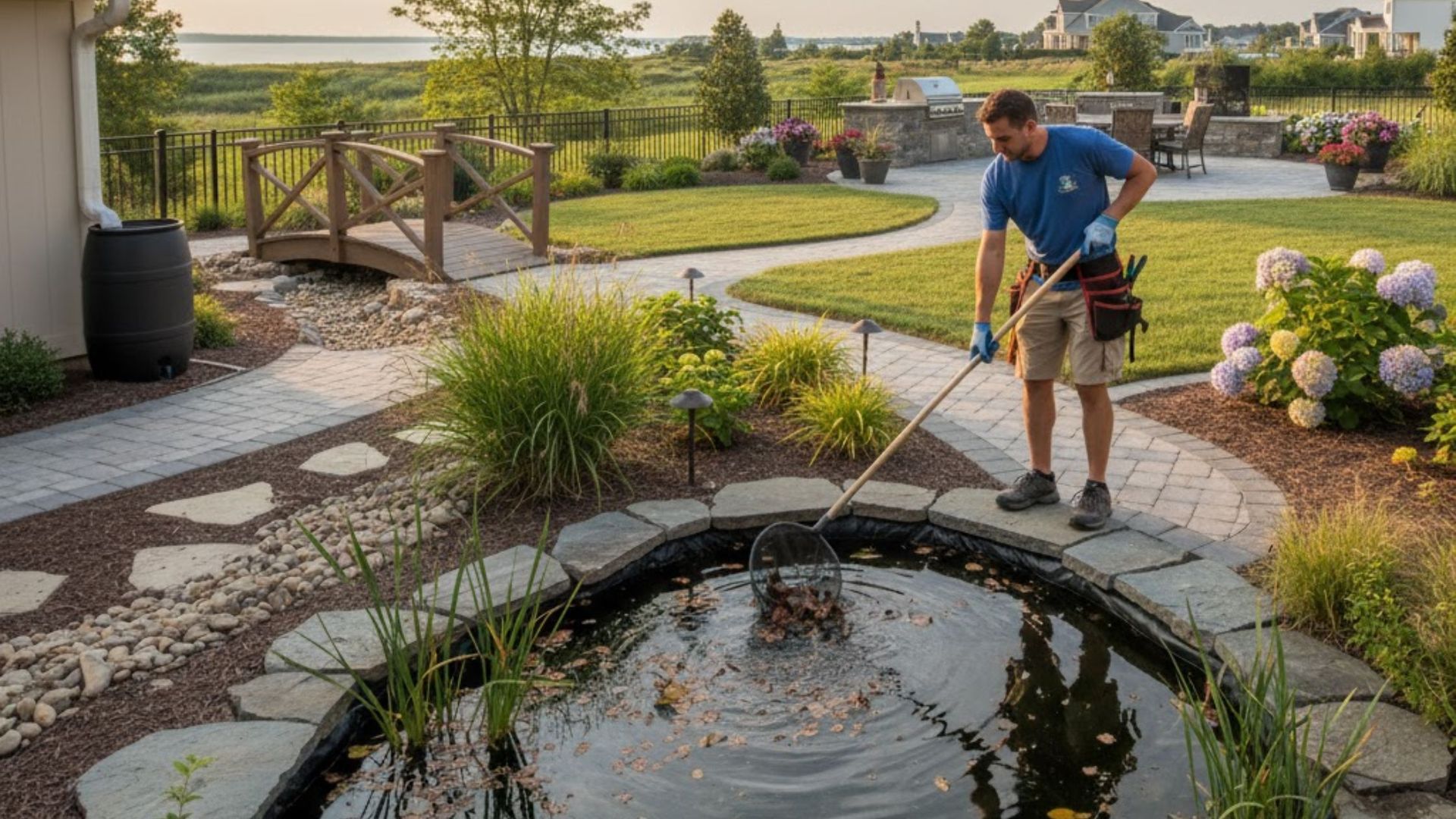How Does Yard Grading Improve Lawn Installation Results in Hampton Roads?

Yard grading is the intentional shaping and leveling of soil to control surface water, create consistent slopes, and prepare a stable base for new sod, and it directly improves drainage and sod longevity.
This article explains how
grading for new sod and landscape leveling in Hampton Roads optimizes lawn preparation, prevents pooling, and reduces future maintenance for coastal plain soils. Homeowners will learn what yard grading involves, how local soil and climate influence grading decisions, step-by-step professional procedures, signs that regrading is needed, how to choose sod and amend soil after grading, and cost versus return on investment. Practical lists, comparison tables, and process checklists are included to help property owners evaluate options and communicate clearly with contractors. Throughout, terms such as grading for new sod, lawn preparation Hampton Roads, and landscape leveling VA are used to connect local needs with best practices for durable, healthy lawns.
What Is Yard Grading and Why Is It Essential for Lawn Installation in Hampton Roads?
Yard grading is the process of reshaping the ground surface to establish proper slopes, eliminate low spots, and create uniform soil profiles for planting, and it functions by directing water flow away from structures and creating a consistent base for sod installation.
Proper grading reduces the risk of standing water, reduces uneven settling, and provides the finish-grade surface that allows roots to establish evenly, improving long-term turf performance.
For lawn preparation in Hampton Roads, grading is essential because local variability in sand, loam, and clay pockets requires tailored slopes and soil blending to handle seasonal rainfall.
The next paragraphs describe what grading physically involves and why those steps matter for new lawns.
What Does Yard Grading Involve?
Yard grading involves a sequence of tasks that prepare the site for sod installation: clearing debris, rough grading to shape large elevations, adding or redistributing topsoil, compacting subgrades, and finish grading with precise leveling tools. Contractors use excavation equipment to correct slope issues, then apply topsoil and perform compaction to achieve a stable base that resists future settling and provides consistent root zone depth. Quality indicators include even surface texture, correct slope percentages away from structures, and absence of low pockets that trap water. Understanding these tasks helps homeowners recognize necessary stages and expected on-site activities before sod installation.
Why Is Yard Grading Crucial for New Lawn Success?
Yard grading is crucial because it creates the physical conditions that allow sod roots to penetrate uniformly, receive even moisture, and avoid localized disease pressure from standing water. When low spots persist, irrigation becomes uneven, nutrients concentrate in some areas and are depleted in others, and turf establishment fails in patches; grading eliminates those patterns by enforcing surface geometry and soil consistency. Well-graded sites also enable irrigation systems to cover lawn areas uniformly, reducing waste and promoting efficient establishment of new sod. Appreciating these mechanisms clarifies why grading is a prerequisite rather than an optional add-on for successful lawn installation.
How Do Hampton Roads’ Soil and Climate Affect Yard Grading Needs?
Hampton Roads features coastal plain soils with variable sand and clay pockets and seasonal heavy rains that make both infiltration and surface runoff important design considerations for grading. Sandy areas drain quickly and may require added organic topsoil for sod rooting, while clay pockets can retain water and need careful slope design and drainage integration to prevent prolonged saturation. Local humidity and summer storms mean grading must emphasize routing water away from foundations and toward safe discharge points, and seasonal timing matters for establishing sod during cooler, wetter windows. These local factors require grading plans tailored to soil tests and drainage forecasts rather than one-size-fits-all leveling.
What Are the Key Benefits of Yard Grading for New Lawns in Hampton Roads?
Yard grading delivers measurable benefits for new lawns by improving drainage, protecting foundations, enhancing turf health, and boosting curb appeal, and these outcomes translate into lower maintenance and longer sod life.
A correctly graded yard routes stormwater away from structures, reduces erosion, and provides a consistent root zone that supports even turf growth.
Homeowners see fewer bare spots, easier mowing, and fewer irrigation adjustments when grading precedes sod installation.
The following subsections break these benefits into practical effects and examples.
Yard grading provides clear, tangible advantages for new lawns in Hampton Roads:
- Improved drainage and reduced standing water enhance plant health and reduce disease pressure.
- Foundation protection and erosion control limit costly structural and landscape damage over time.
- Even root establishment and consistent moisture distribution extend sod longevity and reduce patching.
- A level, well-drained lawn improves curb appeal and simplifies future outdoor additions.
These benefits underscore why grading remains a high-priority investment for homeowners preparing for sod.
How Does Yard Grading Improve Drainage and Prevent Water Pooling?
Grading improves drainage by establishing gentle slopes and low-flow channels that move water away from problem areas, using grade-to-drain principles and eliminating depressions that trap runoff. Ideal residential slopes typically fall in the small-percentage range that safely conveys water without creating erosion, and low spots are filled or recontoured to prevent pooling. Where natural discharge points are distant, grading combines with swales or drainage solutions to carry water to safe outlets, reducing prolonged saturation that damages sod. Proper drainage design reduces the frequency of wet patches and promotes more uniform lawn health across the site.
In What Ways Does Grading Protect Foundations and Prevent Soil Erosion?
Grading protects foundations by directing surface water away from building perimeters and minimizing the volume of water that can seep toward footings, thereby lowering the risk of moisture-related damage. Techniques such as grading away from the foundation, installing shallow swales, and stabilizing slopes with erosion controls keep soil in place during storms. When grading is paired with erosion-control measures and appropriate groundcover, it reduces topsoil loss and prevents gullies that undermine landscape features. These actions together reduce long-term repair needs and help maintain stable planting beds and walkways.
How Does Proper Grading Enhance Lawn Health and Sod Longevity?
Proper grading enhances lawn health by producing an even rooting medium, which encourages uniform root depth and consistent moisture retention, thereby reducing drought stress and disease susceptibility. Uniform surfaces also allow irrigation systems to distribute water more evenly, decreasing overwatered pockets that invite fungal problems. Over the first growing season, homeowners typically notice reduced patchiness and faster sod establishment on well-graded sites, translating to fewer corrective repairs and lower maintenance inputs.
Investing in grading upfront therefore pays off through healthier turf and less frequent replacement of failed patches.
How Can Yard Grading Increase Property Value and Curb Appeal?
Yard grading increases curb appeal by giving lawns a smooth, uniform appearance that complements landscaping and outdoor living features, making properties more attractive to buyers and evaluators. Graded yards present cleaner sightlines for walkways, patios, and water features, and reliable drainage expands the usable landscape area for patios or play spaces.
From a value perspective, grading reduces the risk of visible problems like erosion or standing water that can deter buyers, and it supports long-term landscape durability that prospective owners appreciate. Combining grading with other landscape upgrades often yields better marketability than piecemeal repairs.
How Is Yard Grading Professionally Performed for Optimal Lawn Installation in Hampton Roads?
Professional yard grading begins with a site evaluation, proceeds through coordinated rough and finish grading steps, and ends with quality checks to ensure slopes and compaction meet design goals, ensuring optimal conditions for sod installation. Contractors typically perform soil testing, mark critical elevations, perform bulk earthmoving, add or blend topsoil where needed, and finish-grade using precision tools to deliver a uniform root zone. The process integrates
drainage solutions and may coordinate with irrigation planning to align water routing and delivery. The next subsections outline the detailed procedure, equipment, and how experienced teams tailor work to local soils.
Professionals follow a clear sequence when preparing a yard for sod installation:
- Site evaluation and elevation marking to identify low spots and required slopes.
- Rough grading to move large volumes of soil, followed by soil amendments and compaction.
- Finish grading with precision tools and final inspection before sod is installed.
What Are the Step-by-Step Yard Grading Procedures Before Sod Installation?
The grading workflow typically starts with a site assessment and marking, followed by rough grading to establish overall elevations, then soil amendment and compaction, and ends with finish grading and a final inspection. During the site assessment, contractors document drainage patterns, existing subgrade conditions, and access limitations to plan equipment use and material needs. Rough grading moves bulk soil to correct major slopes, while compaction stabilizes the subgrade. Finish grading uses precision tools to create the final profile that accepts sod and allows irrigation to operate uniformly.
Which Equipment and Techniques Are Used for Precision Yard Leveling?
Precision yard leveling uses a combination of heavy and fine tools such as excavators and skid steers for bulk movement, laser levels or string lines for accurate slope control, and rakes or rollers for finish grading and compaction. Laser-guided blades and laser levels improve accuracy over manual methods, reducing the risk of uneven areas that lead to pooling or poor sod contact. Safety and access considerations determine equipment selection, and smaller properties may use compact machines to minimize turf disturbance. Precision matters because a few inches of variance across a yard can change water flow patterns and sod establishment success.
How Does Hampton Roads Irrigation & Landscape Tailor Grading to Local Conditions?
Local tailoring means adjusting soil amendments, slope design, and drainage integration to match Hampton Roads’ mix of sandy and clay-prone soils and seasonal rainfall patterns, and experienced crews plan for those variations on every job. Hampton Roads Irrigation and Landscape (HR Irrigation) emphasizes careful on-site evaluation and integrates grading with drainage solutions and sprinkler and irrigation systems when appropriate to ensure the finished surface performs under local conditions. Their approach uses state-of-the-art equipment and field knowledge to anticipate common regional challenges, such as slow-draining clay pockets or sandy areas needing topsoil, and to recommend solutions that support successful sod installation.
What Are the Signs That Your Hampton Roads Lawn Needs Professional Yard Grading?
Homeowners should watch for persistent signs that indicate grading issues, because early recognition reduces repair costs and prevents sod failures by allowing timely regrading or targeted fixes.
Visible symptoms include standing water after rains, uneven mowing surfaces, exposed roots or soil loss, and frequent need for patching that suggests underlying grade problems.
Identifying these signs and documenting their frequency helps professionals diagnose whether spot repairs or full regrading is required.
The following list explains common indicators and what they imply.
Common diagnostic signs that
professional grading may be needed:
- Standing water or soggy patches visible after rain indicate poor surface drainage.
- Uneven or sloping areas that interfere with mowing point to grade irregularities.
- Visible soil erosion, exposed roots, or gullies signal failing surface stability.
Recognizing these symptoms early allows homeowners to schedule an evaluation and avoid escalating damage.
How Can You Recognize Drainage Issues Like Water Pooling and Soggy Patches?
Drainage issues present as areas that hold water for hours after rain, become muddy quickly under foot traffic, or show discoloration and turf decline, and simple tests such as timing drainage after rainfall can document severity.
Photographing recurring wet spots and noting their location relative to roof runoff and downspouts helps professionals design effective grade adjustments or drainage channels. Slow-draining spots that fail to dry within 24–48 hours often require corrective grading or the addition of drainage solutions to protect sod. Clear documentation of these behaviors speeds diagnosis during an on-site evaluation.
What Causes Uneven Lawns and Soil Erosion in Hampton Roads?
Uneven lawns result from natural settling, poor initial installation, compaction from heavy equipment, or surface runoff that redistributes soil, while erosion stems from concentrated flows during storms and lack of stabilizing vegetation. Construction activities that alter drainage patterns, removal of vegetation, or compacted subsoils impede infiltration and lead to surface instability.
Preventative grading practices and erosion-control measures such as swales or stabilized channels limit future soil movement. Understanding these causes helps homeowners decide between spot repairs and more comprehensive regrading.
When Is Regrading Necessary to Prepare for New Sod or Landscaping?
Regrading is necessary when low spots exceed a small percentage of the yard, when established slopes direct water toward foundations, or when unevenness prevents proper irrigation coverage, all of which compromise sod success.
Decision thresholds often consider the extent of low areas—if recurring pooling covers a large area or slope direction is wrong for drainage, full regrading is usually recommended over spot leveling. Seasonal timing also matters: regrading followed by sod installation during cooler, wetter periods improves establishment success in Hampton Roads. Evaluating these criteria helps determine project scope and urgency.
How Should Homeowners Choose the Right Sod and Prepare Soil After Yard Grading in Hampton Roads?
Choosing sod and preparing soil after grading ensures the selected turf matches local light, moisture, and soil conditions and that the amended root zone supports rapid establishment. A good selection process considers sun exposure, soil type, and maintenance expectations, while soil testing guides pH and nutrient corrections before sod installation. Post-grade soil preparation includes testing, adding topsoil or organic matter as needed, and achieving correct compaction and finish grade for sod rollout.
The table below compares sod types and their attributes for local use:
Sod Type
Best For / Soil Preference
Value for Hampton Roads
Tall Fescue
Cooler-season lawns, tolerates variable soils
Good in shaded and mixed-sun yards; establish in cooler seasons
Bermudagrass
Warm-season, full sun, tolerates drought
Excellent for sun-dominant yards and heavy use areas
Zoysia
Moderate sun/shade, dense turf, slower growth
Low-maintenance option for balanced sun/shade yards
What Are the Best Sod Types for Hampton Roads’ Climate and Soil?
Best sod choices for Hampton Roads balance warm-season varieties that tolerate high summer heat and humid conditions with cool-season types in shaded microclimates; selection depends on sun exposure and intended use. Bermudagrass and zoysia perform well in sunny, high-traffic areas and handle summer heat, while tall fescue suits shaded yards and cooler-season establishment. Matching sod type to site conditions reduces irrigation needs and disease risk and simplifies long-term maintenance. Homeowners should consider maintenance commitment when choosing between high-performance warm-season grasses and easier-care options.
How Is Soil Tested and Amended for Successful Sod Installation?
Soil testing typically measures pH, nutrient levels, and organic matter; results guide amendments such as lime, sulfur, compost, or starter fertilizer to create an optimal rooting medium. A standard pre-sod checklist includes collecting representative soil samples, applying recommended amendments, and allowing a short settling period before final finish grading. Amending topsoil to the right texture and nutrient balance improves sod rooting and reduces transplant shock. Coordinating amendment timing with grading and sod delivery ensures the surface is ready when turf is installed.
What Are the Best Practices for Caring for New Sod After Grading?
Caring for new sod begins with an immediate, consistent watering schedule to keep the root zone moist, then transitioning to deeper, less frequent watering as roots establish, alongside careful mowing and a delayed fertilization plan. Initial watering frequency often means daily light watering for the first two weeks, then tapering as rooting occurs; mowing typically begins once sod reaches recommended height and shows strong root anchorage. Integrating
sprinkler and irrigation systems with grading ensures uniform coverage and conserves water. Following a clear week-by-week care routine supports faster establishment and protects the grading investment.
What Is the Cost and Return on Investment of Yard Grading for Lawn Installation in Hampton Roads?
Yard grading reduces long-term costs by preventing drainage issues and foundation risks, and the return on investment includes fewer repairs, longer sod life, and improved property marketability, though upfront costs vary by project complexity.
Cost-influencing factors include yard size, slope severity, soil type, site access, and any required permits or drainage installations. Rather than fixed prices, homeowners benefit from understanding relative impacts of these factors.
How Does Yard Grading Save Money by Preventing Drainage and Foundation Damage?
Grading prevents expensive downstream repairs by keeping water away from foundations, reducing mold and structural issues, and limiting erosion that can necessitate landscape rebuilding. A concept-level comparison shows that small proactive grading investments often cost a fraction of the price of structural repair or repeated lawn replacement over time. Maintenance savings also accumulate through reduced patching, lower disease treatment needs, and more efficient irrigation. Considering these savings frames grading as a risk-management and asset-preservation measure.
What Are Typical Yard Grading Costs in Hampton Roads?
Typical costs vary widely because prices reflect site-specific variables rather than a single rate; common pricing frameworks consider square footage, depth of earthwork, and required drainage solutions. Homeowners should treat example ranges as illustrative and request a
free estimate for an accurate quote, since access, soil amendments, and integration with sprinkler and irrigation systems change final pricing. Clear documentation of site conditions and desired outcomes helps contractors produce accurate bids. A free evaluation allows precise scoping and transparent cost discussion.
How Does Proper Grading Increase Property Value and ROI?
Proper grading increases perceived property value by presenting a functional, attractive landscape and by reducing risk factors that buyers note during inspections, which can improve marketability. Function-driven improvements like reliable drainage, stable lawns, and readiness for patios or outdoor living features enhance buyer confidence and can justify higher asking prices. Combining grading with other landscape upgrades typically yields better returns than isolated fixes. Homeowners who integrate grading into broader landscape plans position their properties for stronger long-term value retention.
How Can You Get a Free Estimate and Professional Yard Grading Service in Hampton Roads?
Scheduling a free on-site estimate begins with contacting local providers to request an evaluation, during which professionals inspect drainage patterns, soil conditions, and slopes and then deliver recommendations and a rough cost estimate. A typical estimate visit includes site photos, notes on problem areas, proposed grading strategy, and identification of additional services such as drainage solutions or sprinkler and irrigation integration. Preparing photos and descriptions of recurring issues speeds the process and improves quote accuracy.
When preparing for a free estimate, homeowners should gather key information:
- Photos of problem areas and notes on how long pooling persists after rain.
- Measurements or approximate yard dimensions and known access constraints.
- Questions about integration with other services such as drainage solutions and sprinkler and irrigation systems.
Providing this information improves the on-site evaluation and helps contractors produce a more accurate proposal.
Why Choose Hampton Roads Irrigation & Landscape for Yard Grading and Sod Installation?
Hampton Roads Irrigation and Landscape positions itself as a full-service provider offering grading and sod installation, drainage solutions, sprinkler and irrigation systems, and related landscape services, using experienced crews and state-of-the-art equipment. Their approach emphasizes tailored grading for local soil and slope conditions and coordination across drainage and irrigation work to ensure site performance.
HR Irrigation also promotes free on-site estimates and carries insurance, offering homeowners a single-source solution for site preparation and turf installation. These service attributes help homeowners align grading projects with broader landscape plans.
How to Schedule a Free On-Site Yard Grading Evaluation?
To schedule a free on-site evaluation, prepare photos and notes about problem areas, request an appointment through the provider’s contact options, and expect a site visit that includes inspection, recommendations, and a rough cost overview. During the visit, the evaluator documents drainage behavior, measures slopes, and outlines next steps and timing for work. Typical follow-up includes a written estimate and suggested scope for grading and any recommended drainage or irrigation work. Being ready with site details accelerates the estimate and helps prioritize interventions.
What Do Customers Say About Our Yard Grading Results?
Customer feedback for local providers typically highlights effective drainage fixes, improved lawn establishment after grading, and professional coordination when grading is combined with sod installation and irrigation work; reviews can be found on the provider’s review pages and informational hubs. Prospective clients should review recent case studies or before-and-after galleries where available to confirm expected outcomes and to see real examples of grading and sod longevity. Reading multiple reviews and viewing project galleries helps set realistic expectations about timelines and results. Those references reinforce confidence in selecting a qualified local team for grading and lawn preparation.
Frequently Asked Questions
What are the long-term benefits of yard grading for homeowners?
Yard grading offers several long-term benefits for homeowners, including improved drainage, reduced risk of foundation damage, and enhanced lawn health. By directing water away from structures, grading minimizes the chances of moisture-related issues, which can lead to costly repairs. Additionally, a well-graded lawn promotes even sod establishment, resulting in a healthier, more resilient turf that requires less maintenance over time. These factors contribute to increased property value and curb appeal, making grading a worthwhile investment for any homeowner.
How can I identify if my lawn has drainage problems?
Identifying drainage problems in your lawn can be done by observing specific signs. Look for areas that remain soggy or muddy long after rainfall, as well as patches of grass that appear discolored or unhealthy. Additionally, if you notice water pooling in certain spots or if your lawn has developed uneven surfaces, these are indicators of poor drainage. Conducting a simple drainage test by timing how long it takes for water to disappear can also help assess the severity of the issue.
What is the best time of year to schedule yard grading?
The best time to schedule yard grading typically falls in the early spring or fall, when soil moisture levels are optimal for grading activities. During these seasons, the ground is usually softer, making it easier to reshape and level the soil. Additionally, scheduling grading before sod installation during these cooler months can enhance sod establishment, as the grass will have the right conditions to root effectively. Avoiding extreme weather conditions, such as heavy rains or freezing temperatures, is also advisable for successful grading.
Can I perform yard grading myself, or should I hire a professional?
While some homeowners may attempt DIY yard grading, hiring a professional is often recommended for optimal results. Professionals have the necessary equipment, expertise, and experience to assess site conditions accurately and execute grading effectively. They can identify drainage issues, ensure proper slope design, and integrate necessary drainage solutions. Additionally, improper grading can lead to further problems, such as erosion or poor sod establishment, making professional assistance a worthwhile investment for long-term lawn health.
What types of soil amendments are beneficial after grading?
After grading, several soil amendments can enhance the quality of the soil for sod installation. Common amendments include organic matter, such as compost, which improves soil structure and nutrient content. Additionally, lime or sulfur may be added to adjust soil pH, ensuring optimal conditions for grass growth. Incorporating topsoil can also help create a suitable rooting medium. Conducting a soil test prior to amendments is crucial to determine specific nutrient needs and achieve the best results for your lawn.
How does yard grading impact the effectiveness of irrigation systems?
Yard grading significantly impacts the effectiveness of irrigation systems by creating a level surface that promotes uniform water distribution. Proper grading prevents low spots where water can accumulate, ensuring that all areas of the lawn receive adequate moisture. This uniformity reduces the risk of overwatering certain patches while leaving others dry, which can lead to uneven growth. By integrating grading with irrigation planning, homeowners can optimize water usage, promote healthier sod establishment, and lower overall water costs.
What should I expect during a professional yard grading evaluation?
During a professional yard grading evaluation, you can expect a thorough assessment of your property. The contractor will inspect drainage patterns, soil conditions, and existing slopes to identify any issues. They will take measurements and may document problem areas with photos. After the evaluation, the contractor will provide recommendations for grading solutions, discuss potential costs, and outline the next steps. This evaluation is crucial for developing a tailored grading plan that meets your lawn's specific needs.
What are the common signs that indicate my lawn needs regrading?
Common signs that your lawn may need regrading include persistent standing water after rainfall, uneven mowing surfaces, and visible soil erosion or exposed roots. If you notice areas that remain soggy for extended periods or if your lawn has developed low spots that trap water, these are clear indicators of drainage issues. Additionally, if you find yourself frequently patching bare spots, it may suggest underlying grade problems that require professional assessment and potential regrading to ensure a healthy lawn.
How can I prepare my lawn for sod installation after grading?
Preparing your lawn for sod installation after grading involves several key steps. First, conduct soil testing to assess pH and nutrient levels, which will guide necessary amendments. Next, ensure that the graded surface is compacted properly and free of debris. Adding organic matter or topsoil can enhance the rooting medium. Finally, allow the soil to settle before laying sod, ensuring that the surface is level and ready for optimal sod establishment. Following these steps will promote a successful lawn installation.
What factors influence the cost of yard grading in Hampton Roads?
The cost of yard grading in Hampton Roads is influenced by several factors, including the size of the yard, the severity of the slope, soil type, and site access. Larger areas typically incur higher labor and material costs, while steeper slopes may require more extensive excavation and stabilization efforts. Additionally, if the soil is clay-heavy or contaminated, it may necessitate importing topsoil, further increasing costs. Homeowners should consider these variables when budgeting for grading projects and seek detailed estimates from contractors.
How does yard grading affect irrigation efficiency?
Yard grading significantly impacts irrigation efficiency by creating a level surface that allows for uniform water distribution. Properly graded lawns prevent low spots where water can pool, ensuring that all areas receive adequate moisture. This uniformity reduces the risk of overwatering certain patches while leaving others dry, which can lead to uneven growth and increased maintenance. By integrating grading with irrigation planning, homeowners can optimize water usage, promote healthier sod establishment, and lower overall water costs.
What maintenance practices should I follow after sod installation?
After sod installation, it’s crucial to establish a consistent maintenance routine to ensure healthy growth. Begin with frequent, light watering to keep the root zone moist, gradually transitioning to deeper, less frequent watering as the roots establish. Avoid mowing until the sod reaches the recommended height and shows strong root anchorage. Additionally, delay fertilization until the sod is well-rooted, and monitor for any signs of disease or stress. Following these practices will support faster establishment and protect your investment in grading and sod.
Can yard grading help with pest control in my lawn?
Yes, yard grading can indirectly assist with pest control in your lawn. By improving drainage and reducing standing water, grading minimizes the conditions that attract pests such as mosquitoes and certain lawn diseases. Proper grading also promotes healthy turf growth, which can naturally resist pests and diseases. A well-graded lawn allows for better air circulation and sunlight penetration, creating an environment that is less conducive to pest infestations. Thus, investing in grading can contribute to a healthier, more resilient lawn ecosystem.
How often should I consider regrading my lawn?
Regrading should be considered when you notice persistent drainage issues, such as standing water or uneven surfaces that interfere with mowing. Additionally, if your lawn has experienced significant settling, erosion, or if you are planning major landscaping changes, regrading may be necessary. Regular inspections, especially after heavy rains or storms, can help identify when regrading is needed. Homeowners should also consider regrading every few years as part of routine lawn maintenance to ensure optimal conditions for sod health and longevity.
Conclusion
Yard grading is essential for achieving a healthy, vibrant lawn in Hampton Roads, as it enhances drainage, protects foundations, and promotes even sod establishment. By understanding the grading process and its benefits, homeowners can make informed decisions that lead to long-term lawn success and increased property value. Don't wait for drainage issues to escalate; take proactive steps to ensure your yard is properly graded for optimal results. Contact us today for a free on-site evaluation and let our experts help you create the lawn of your dreams.
